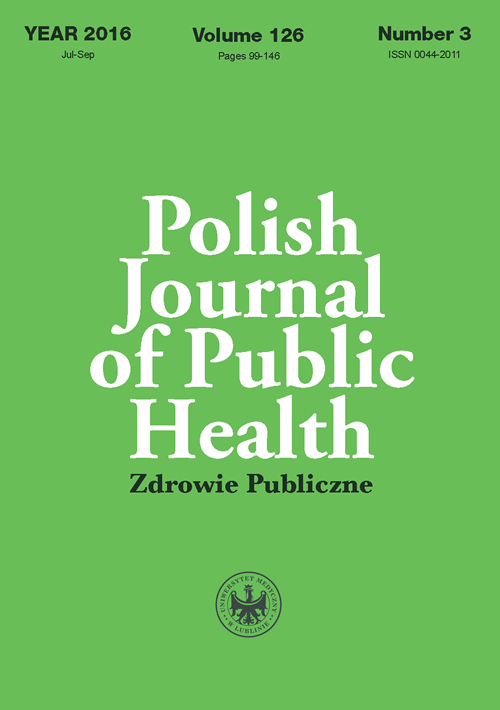Most frequent problems of pregnant women with gestational diabetes mellitus
DOI:
https://doi.org/10.1515/pjph-2016-0022Keywords:
gestational diabetes, pregnant women, problemsAbstract
Introduction. Gestational diabetes mellitus (GDM) is the most common metabolic disorder happening to pregnant women. Some. 3-5% of all pregnant women in Poland are diagnosed with the condition. Glucose tolerance disorders or gestational diabetes recur in about 30% of women during their second (or next) pregnancy. Controlling diabetes involves many new responsibilities and sacrifices that may be difficult to bear for a pregnant woman.
Aim. The aim of the present study was to examine the most common problems among pregnant women with gestational diabetes.
Material and methods. The study was conducted between 2015 and 2016. The authors used a diagnostic survey on 120 pregnant women with diabetes who were patients in gestational pathology and conservative gynecological treatment departments and diabetic outpatient clinics in Lublin. The χ2 test of independence was used to examine correlations between socio-demographic factors and problems experienced by pregnant women with gestational diabetes.
Results. Problems with keeping a blood glucose monitoring diary were reported by women from cities different than province capitals (75%). Childless women reported problems with pricking their finger multiple times a day (60%). Insulin injections were perceived as a GDM-related problem mostly by women aged 31-35 (41.2%), women in their second pregnancy (61.8%) and women with more than one child (47.1%). Frequent visits to the doctor were perceived as a problem mostly by women aged less than 26 (42.3%), women living in rural areas (57.7%), women with higher education (84.6%), women in their first pregnancy (61.5%) and women without children (73.1%). The two last groups additionally indicated psychological burden (84.2% and 78.9%, respectively). Anxiety about the occurrence of type 2 diabetes was mainly expressed by women aged 26-30 (35.3%) and those in their second pregnancy (52.9%), whilst working women expressed concern for their own lives (78.6%).
Conclusions. There is a correlation between selected problems experienced by pregnant women with GDM and socio-demographic variables such as: age, place of residence, education, professional activity and number of pregnancies and children. The results obtained suggest that there is a need for educating women about the most frequent problems that accompany pregnancy with GDM.
References
1. Grzelak T, Janicka E, Kramkowska M, et al. Cukrzyca ciążowa – skutki niewyrównania i podstawy regulacji glikemii. Now Lek. 2013;82(8):163-9.
2. Molęda P, Fronczyk A, Jabłońska K, et al. Praktyczna realizacja zaleceń dotyczących diagnostyki cukrzycy ciążowej. Ginekol Pol. 2015;86:132-6.
3. Zalecenia kliniczne dotyczące postępowania u chorych na cukrzycę 2016. Stanowisko Polskiego Towarzystwa Diabetologicznego. Diabetologia Kliniczna 2016;5(Supl.A): A49-A51.
4. Majda A, Walas K, Samoiluk O. Jakość życia kobiet z cukrzycą ciążową. Probl Pielęg. 2014;22(4):459-63.
5. Kopacz K, Myśliwiec M, Techmańska I, et al. Cukrzyca ciążowa – narastający problem diagnostyczny i epidemiologiczny. Diabetol Prakt. 2011;12 (3):96-102.
6. Kutowska J, Gierszewska M, Mieczkowska E, et al. Quality of life among women with gestational diabetes mellitus. Med Biol Sci. 2012;26(1):133-8.
7. Kalka D. Poczucie jakości życia a objawy depresji i sposoby radzenia sobie ze stresem u osób z cukrzycą typu 2 – doniesienia wstępne. Psychiatr Pol. 2014;48(5):931-40.
8. Morylowska-Topolska J, Makara-Studzińska M, Kotarski J. Wpływ wybranych zmiennych socjodemograficznych i medycznych na nasilenie objawów lękowych i depresyjnych w poszczególnych trymestrach ciąży. Psychiatr Pol. 2014;48(1):173-86.
9. Lee AM, Keung Lam S, Sze Mun Lau SM, et al. Prevalence, course risk factors for antenatal anxiety and depression. Obstet Gynecol. 2007;110(5):1102-12.
10. Towpik I, Wender-Ożegnowska E. Czy warto leczyć cukrzycę ciążową. Ginekol Pol. 2014;85:220-5.
11. Bień A, Rzońca E, Kańczugowska A, Iwanowicz-Palus G. Factors affecting the quality of life and the illness acceptance of pregnant women with diabetes. Int J Environ Res Public Health. 2016;13(1):1-13.
12. Chudiak A, Lomper K, Jankowska-Polańska B, Uchmanowicz I. Wpływ edukacji diabetologicznej na ocenę jakości życia chorych z cukrzycą typu 2. Probl Pielęg. 2015;23(1):1-6.
13. Bomba-Opoń D, Brązert J, Celewicz Z. Standardy Polskiego Towarzystwa Ginekologicznego postępowania u kobiet z cukrzycą – aktualizacja. Ginekol Pol. 2014;85:476-8.
Downloads
Published
Issue
Section
License
Copyright (c) 2016 Polish Journal of Public Health

This work is licensed under a Creative Commons Attribution-NonCommercial-NoDerivatives 3.0 Unported License.


